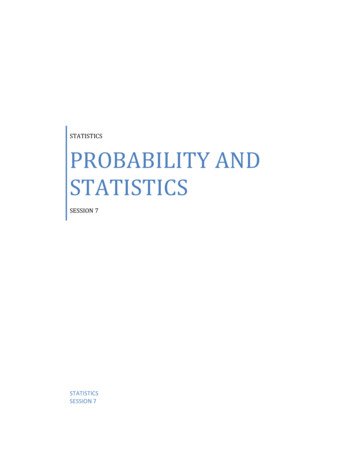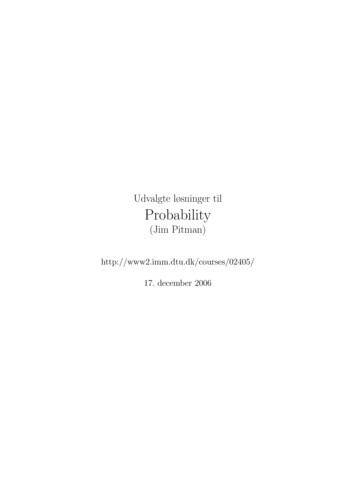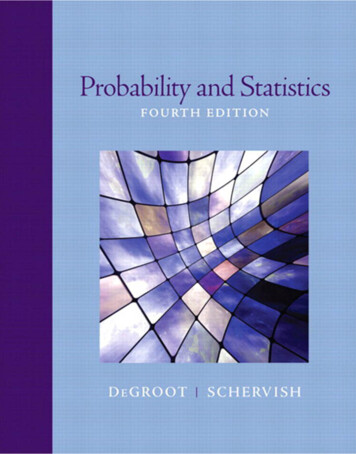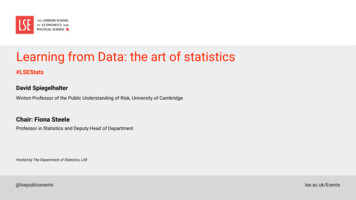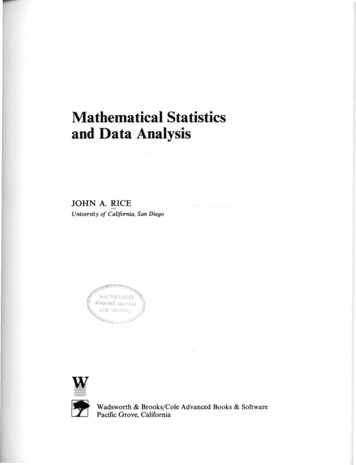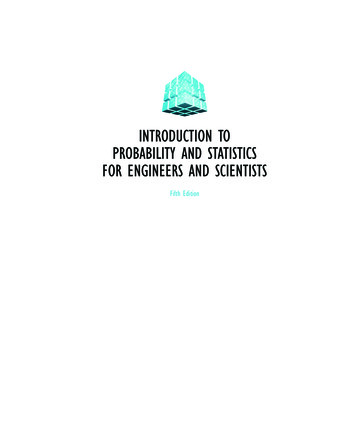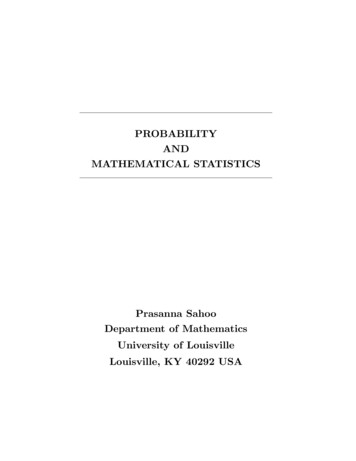
Transcription
PROBABILITYANDMATHEMATICAL STATISTICSPrasanna SahooDepartment of MathematicsUniversity of LouisvilleLouisville, KY 40292 USA
vTHIS BOOK IS DEDICATED TOAMITSADHNAMY PARENTS, TEACHERSANDSTUDENTS
vi
viicCopyright 2003.All rights reserved. This book, or parts thereof, maynot be reproduced in any form or by any means, electronic or mechanical,including photocopying, recording or any information storage and retrievalsystem now known or to be invented, without written permission from theauthor.
viii
ixPREFACEThis book is both a tutorial and a textbook. In this book we present anintroduction to probability and mathematical statistics and it is intended forstudents already having some elementary mathematical background. It isintended for a one-year senior level undergraduate and beginning graduatelevel course in probability theory and mathematical statistics. The bookcontains more material than normally would be taught in a one-year course.This should give the teacher flexibility with respect to the selection of thecontent and level at which the book is to be used. It has arisen from over 15years of lectures in senior level calculus based courses in probability theoryand mathematical statistics at the University of Louisville.Probability theory and mathematical statistics are difficult subjects bothfor students to comprehend and teachers to explain. A good set of examples makes these subjects easy to understand. For this reason alone we haveincluded more than 350 completely worked out examples and over 165 illustrations. We give a rigorous treatment of the fundamentals of probabilityand statistics using mostly calculus. We have given great attention to theclarity of the presentation of the materials. In the text theoretical resultsare presented as theorems, proposition or lemma, of which as a rule rigorousproofs are given. In the few exceptions to this rule references are given toindicate where details can be found. This book contains over 450 problemsof varying degrees of difficulty to help students master their problem solvingskill. To make this less wordy we haveThere are several good books on these subjects and perhaps there isno need to bring a new one to the market. So for several years, this wascirculated as a series of typeset lecture notes among my students who werepreparing for the examination 110 of the Actuarial Society of America. Manyof my students encouraged me to formally write it as a book. Actuarialstudents will benefit greatly from this book. The book is written in simpleEnglish; this might be an advantage to students whose native language is notEnglish.
xI cannot claim that all the materials I have written in this book are mine.I have learned the subject from many excellent books, such as Introductionto Mathematical Statistics by Hogg and Craig, and An Introduction to Probability Theory and Its Applications by Feller. In fact, these books have had aprofound impact on me, and my explanations are influenced greatly by thesetextbooks. If there are some resemblances, then it is perhaps due to the factthat I could not improve the original explanations I have learned from thesebooks. I am very thankful to the authors of these great textbooks. I amalso thankful to the Actuarial Society of America for letting me use theirtest problems. I thank all my students in my probability theory and mathematical statistics courses from 1988 to 2003 who helped me in many waysto make this book possible in the present form. Lastly, if it wasn’t for theinfinite patience of my wife, Sadhna, for last several years, this book wouldnever gotten out of the hard drive of my computer.The entire book was typeset by the author on a Macintosh computerusing TEX, the typesetting system designed by Donald Knuth. The figureswere generated by the author using MATHEMATICA, a system for doingmathematics designed by Wolfram Research, and MAPLE, a system for doingmathematics designed by Maplesoft. The author is very thankful to theUniversity of Louisville for providing many internal financial grants whilethis book was under preparation.Prasanna Sahoo, Louisville
xi
xiiTABLE OF CONTENTS1. Probability of Events. . . . . . . . . . . . . . . . . . .11.1. Introduction1.2. Counting Techniques1.3. Probability Measure1.4. Some Properties of the Probability Measure1.5. Review Exercises2. Conditional Probability and Bayes’ Theorem. . . . . . . 272.1. Conditional Probability2.2. Bayes’ Theorem2.3. Review Exercises3. Random Variables and Distribution Functions . . . . . . . 453.1. Introduction3.2. Distribution Functions of Discrete Variables3.3. Distribution Functions of Continuous Variables3.4. Percentile for Continuous Random Variables3.5. Review Exercises4. Moments of Random Variables and Chebychev Inequality . 734.1. Moments of Random Variables4.2. Expected Value of Random Variables4.3. Variance of Random Variables4.4. Chebychev Inequality4.5. Moment Generating Functions4.6. Review Exercises
xiii5. Some Special Discrete Distributions . . . . . . . . . . .1075.1. Bernoulli Distribution5.2. Binomial Distribution5.3. Geometric Distribution5.4. Negative Binomial Distribution5.5. Hypergeometric Distribution5.6. Poisson Distribution5.7. Riemann Zeta Distribution5.8. Review Exercises6. Some Special Continuous Distributions. . . . . . . . .141. . . . . . . . . . . . . . . . .1856.1. Uniform Distribution6.2. Gamma Distribution6.3. Beta Distribution6.4. Normal Distribution6.5. Lognormal Distribution6.6. Inverse Gaussian Distribution6.7. Logistic Distribution6.8. Review Exercises7. Two Random Variables7.1. Bivariate Discrete Random Variables7.2. Bivariate Continuous Random Variables7.3. Conditional Distributions7.4. Independence of Random Variables7.5. Review Exercises8. Product Moments of Bivariate Random Variables . . . .8.1. Covariance of Bivariate Random Variables8.2. Independence of Random Variables8.3. Variance of the Linear Combination of Random Variables8.4. Correlation and Independence8.5. Moment Generating Functions8.6. Review Exercises213
xiv9. Conditional Expectations of Bivariate Random Variables2379.1. Conditional Expected Values9.2. Conditional Variance9.3. Regression Curve and Scedastic Curves9.4. Review Exercises10. Functions of Random Variables and Their Distribution .25710.1. Distribution Function Method10.2. Transformation Method for Univariate Case10.3. Transformation Method for Bivariate Case10.4. Convolution Method for Sums of Random Variables10.5. Moment Method for Sums of Random Variables10.6. Review Exercises11. Some Special Discrete Bivariate Distributions. . . . .28912. Some Special Continuous Bivariate Distributions . . . .31711.1. Bivariate Bernoulli Distribution11.2. Bivariate Binomial Distribution11.3. Bivariate Geometric Distribution11.4. Bivariate Negative Binomial Distribution11.5. Bivariate Hypergeometric Distribution11.6. Bivariate Poisson Distribution11.7. Review Exercises12.1. Bivariate Uniform Distribution12.2. Bivariate Cauchy Distribution12.3. Bivariate Gamma Distribution12.4. Bivariate Beta Distribution12.5. Bivariate Normal Distribution12.6. Bivariate Logistic Distribution12.7. Review Exercises
xv13. Sequences of Random Variables and Order Statistics . .35113.1. Distribution of Sample Mean and Variance13.2. Laws of Large Numbers13.3. The Central Limit Theorem13.4. Order Statistics13.5. Sample Percentiles13.6. Review Exercises14. Sampling Distributions Associated withthe Normal Population . . . . . . . . . . . . . . . . .38914.1. Chi-square distribution14.2. Student’s t-distribution14.3. Snedecor’s F -distribution14.4. Review Exercises15. Some Techniques for Finding PointEstimators of Parameters. . . . . . . . . . . . . . .40715.1. Moment Method15.2. Maximum Likelihood Method15.3. Bayesian Method15.3. Review Exercises16. Criteria for Evaluating the Goodnessof Estimators. . . . . . . . . . . . . . . . . . . . .16.1. The Unbiased Estimator16.2. The Relatively Efficient Estimator16.3. The Minimum Variance Unbiased Estimator16.4. Sufficient Estimator16.5. Consistent Estimator16.6. Review Exercises447
xvi17. Some Techniques for Finding IntervalEstimators of Parameters. . . . . . . . . . . . . . .48717.1. Interval Estimators and Confidence Intervals for Parameters17.2. Pivotal Quantity Method17.3. Confidence Interval for Population Mean17.4. Confidence Interval for Population Variance17.5. Confidence Interval for Parameter of some Distributionsnot belonging to the Location-Scale Family17.6. Approximate Confidence Interval for Parameter with MLE17.7. The Statistical or General Method17.8. Criteria for Evaluating Confidence Intervals17.9. Review Exercises18. Test of Statistical Hypotheses. . . . . . . . . . . . .53118.1. Introduction18.2. A Method of Finding Tests18.3. Methods of Evaluating Tests18.4. Some Examples of Likelihood Ratio Tests18.5. Review Exercises19. Simple Linear Regression and Correlation Analysis. .57520. Analysis of Variance . . . . . . . . . . . . . . . . . .20.1. One-way Analysis of Variance with Equal Sample Sizes20.2. One-way Analysis of Variance with Unequal Sample Sizes20.3. Pair wise Comparisons20.4. Tests for the Homogeneity of Variances20.5. Review Exercises61119.1. Least Squared Method19.2. Normal Regression Analysis19.3. The Correlation Analysis19.4. Review Exercises
xvii21. Goodness of Fits Tests . . . . . . . . . . . . . . . . .21.1. Chi-Squared test21.2. Kolmogorov-Smirnov test21.3. Review Exercises643References . . . . . . . . . . . . . . . . . . . . . . . . .659Answers to Selected Review Exercises665. . . . . . . . . . .
Probability and Mathematical Statistics351Chapter 13SEQUENCESOFRANDOM VARIABLESANDORDER STASTISTICSIn this chapter, we generalize some of the results we have studied in theprevious chapters. We do these generalizations because the generalizationsare needed in the subsequent chapters relating mathematical statistics. Inthis chapter, we also examine the weak law of large numbers, the Bernoulli’slaw of large numbers, the strong law of large numbers, and the central limittheorem. Further, in this chapter, we treat the order statistics and percentiles.13.1. Distribution of sample mean and varianceConsider a random experiment. Let X be the random variable associated with this experiment. Let f (x) be the probability density function of X.Let us repeat this experiment n times. Let Xk be the random variable associated with the k th repetition. Then the collection of the random variables{ X1 , X2 , ., Xn } is a random sample of size n. From here after, we simplydenote X1 , X2 , ., Xn as a random sample of size n. The random variablesX1 , X2 , ., Xn are independent and identically distributed with the commonprobability density function f (x).For a random sample, functions such as the sample mean X, the samplevariance S 2 are called statistics. In a particular sample, say x1 , x2 , ., xn , we
Sequences of Random Variables and Order Statistics352observed x and s2 . We may considerX andS2 n1 Xin i 1n 21 Xi Xn 1 i 1as random variables and x and s2 are the realizations from a particularsample.In this section, we are mainly interested in finding the probability distributions of the sample mean X and sample variance S 2 , that is the distributionof the statistics of samples.Example 13.1. Let X1 and X2 be a random sample of size 2 from a distribution with probability density function if 0 x 1f (x) 6x(1 x)0otherwise.What are the mean and variance of sample sum Y X1 X2 ?Answer: The population meanµX E (X) 1 x 6x(1 x) dx0 1x2 (1 x) dx 60 6 B(3, 2)(here B denotes the beta function)Γ(3) Γ(2) 6Γ(5) 1 6121 .2Since X1 and X2 have the same distribution, we obtain µX1 Hence the mean of Y is given byE(Y ) E(X1 X2 ) E(X1 ) E(X2 )1 1 2 2 1.12 µX2 .
Probability and Mathematical Statistics353Next, we compute the variance of the population X. The variance of X isgiven by V ar(X) E X 2 E(X)2 2 113 6x (1 x) dx 20 11 6x3 (1 x) dx 40 1 6 B(4, 2) 4 Γ(4) Γ(2)1 6 Γ(6)4 11 6 20465 20 201 .20Since X1 and X2 have the same distribution as the population X, we getV ar(X1 ) 1 V ar(X2 ).20Hence, the variance of the sample sum Y is given byV ar(Y ) V ar (X1 X2 ) V ar (X1 ) V ar (X2 ) 2 Cov (X1 , X2 ) V ar (X1 ) V ar (X2 )11 20 201 .10Example 13.2. Let X1 and X2 be a random sample of size 2 from a distribution with density 1f (x) 4for x 1, 2, 3, 40otherwise.What is the distribution of the sample sum Y X1 X2 ?
Sequences of Random Variables and Order Statistics354Answer: Since the range space of X1 as well as X2 is {1, 2, 3, 4}, the rangespace of Y X1 X2 isRY {2, 3, 4, 5, 6, 7, 8}.Let g(y) be the density function of Y . We want to find this density function.First, we find g(2), g(3) and so on.g(2) P (Y 2) P (X1 X2 2) P (X1 1 and X2 1) P (X1 1) P (X2 1)(by independence of X1 and X2 ) f (1) f (1) 111 .4416g(3) P (Y 3) P (X1 X2 3) P (X1 1 and X2 2) P (X1 2 and X2 1) P (X1 1) P (X2 2) P (X1 2) P (X2 1) f (1) f (2) f (2) f (1) 11112 .444416(by independence of X1 and X2 )
Probability and Mathematical Statistics355g(4) P (Y 4) P (X1 X2 4) P (X1 1 and X2 3) P (X1 3 and X2 1) P (X1 2 and X2 2) P (X1 3) P (X2 1) P (X1 1) P (X2 3) P (X1 2) P (X2 2)(by independence of X1 and X2 ) f (1) f (3) f (3) f (1) f (2) f (2) 111111 4444443 .16Similarly, we getg(5) 4,16g(6) 3,16g(7) 2,16g(8) 1.16Thus, putting these into one expression, we getg(y) P (Y y) y 1 f (k) f (y k)k 1 4 y 5 ,16Remark 13.1. Note that g(y) y 1 y 2, 3, 4, ., 8.f (k) f (y k) is the discrete convolutionk 1of f with itself. The concept of convolution was introduced in chapter 10.The above example can also be done using the moment generating func-
Sequences of Random Variables and Order Statistics356tion method as follows:MY (t) MX1 X2 (t) MX1 (t) MX2 (t) t t e e2t e3t e4te e2t e3t e4t 44 t 2t3t4t 2e e e e 4e2t 2e3t 3e4t 4e5t 3e6t 2e7t e8t .16Hence, the density of Y is given byg(y) 4 y 5 ,16y 2, 3, 4, ., 8.Theorem 13.1. If X1 , X2 , ., Xn are mutually independent random variables with densities f1 (x1 ), f2 (x2 ), ., fn (xn ) and E[ui (Xi )], i 1, 2, ., nexist, then n n11Eui (Xi ) E[ui (Xi )],i 1i 1where ui (i 1, 2, ., n) are arbitrary functions.Proof: We prove the theorem assuming that the random variablesX1 , X2 , ., Xn are continuous. If the random variables are not continuous,then the proof follows exactly in the same manner if one replaces the integralsby summations. SinceEn1ui (Xi )i 1 E(u1 (X1 ) · · · un (Xn )) ···u1 (x1 ) · · · un (xn )f (x1 , ., xn )dx1 · · · dxn ···u1 (x1 ) · · · un (xn )f1 (x1 ) · · · fn (xn )dx1 · · · dxn u1 (x1 )f1 (x1 )dx1 · · ·un (x1 )fn (xn )dxn E (u1 (X1 )) · · · E (un (Xn ))n1 E (ui (Xi )) ,i 1
Probability and Mathematical Statistics357the proof of the theorem is now complete.Example 13.3. Let X and Y be two random variables with the joint density (x y)efor 0 x, y f (x, y) 0otherwise.What is the expected value of the continuous random variable Z X 2 Y 2 XY 2 X 2 X?Answer: Sincef (x, y) e (x y) e x e y f1 (x) f2 (y),the random variables X and Y are mutually independent. Hence, the expected value of X is E(X) x f1 (x) dx 0 xe x dx0 Γ(2) 1.Similarly, the expected value of X 2 is given by E X2 x2 f1 (x) dx0 x2 e x dx0 Γ(3) 2.Since the marginals of X and Y are same, we also get E(Y ) 1 and E(Y 2 ) 2. Further, by Theorem 13.1, we get E [Z] E X 2 Y 2 XY 2 X 2 X E X2 X Y 2 1 E X2 X E Y 2 1(by Theorem 13.1) 2 2 E X E [X] E Y 1 (2 1) (2 1) 9.
Sequences of Random Variables and Order Statistics358Theorem 13.2. If X1 , X2 , ., Xn are mutually independent random variables with respective means µ1 , µ2 , ., µn and variances σ12 , σ22 , ., σn2 , then nthe mean and variance of Y i 1 ai Xi , where a1 , a2 , ., an are real constants, are given byµY n ai µiσY2 andi 1n a2i σi2 .i 1Proof: First we show that µY ni 1ai µi . SinceµY E(Y ) En ai Xii 1 n i 1n ai E(Xi )ai µii 1we have asserted result. Next we show σY2 ni 1a2i σi2 . ConsiderσY2 V ar(Y ) V ar (ai Xi )n a2i V ar (Xi )i 1 n a2i σi2 .i 1This completes the proof of the theorem.Example 13.4. Let the independent random variables X1 and X2 havemeans µ1 4 and µ2 3, respectively and variances σ12 4 and σ22 9.What are the mean and variance of Y 3X1 2X2 ?Answer: The mean of Y isµY 3µ1 2µ2 3( 4) 2(3) 18.
Probability and Mathematical Statistics359Similarly, the variance of Y isσY2 (3)2 σ12 ( 2)2 σ22 9 σ12 4 σ22 9(4) 4(9) 72.Example 13.5. Let X1 , X2 , ., X50 be a random sample of size 50 from adistribution with density 1 xθfor 0 x θ ef (x) 0otherwise.What are the mean and variance of the sample mean X?Answer: Since the distribution of the population X is exponential, the meanand variance of X are given byµX θ,and2σX θ2 .Thus, the mean of the sample mean is X1 X2 · · · X50E X E50 501 E (Xi )50 i 1 501 θ50 i 1150 θ θ.50The variance of the sample mean is given by 50 1V ar X V arXi50i 1 250 12 σXi50i 1 250 1 θ250i 1 21 50θ250θ2 .50
Sequences of Random Variables and Order Statistics360Theorem 13.3. If X1 , X2 , ., Xn are independent random variables withrespective moment generating functions MXi (t), i 1, 2, ., n, then the mo nment generating function of Y i 1 ai Xi is given byMY (t) n1MXi (ai t) .i 1Proof: SinceMY (t) M ni 1 n1i 1n1ai Xi (t)Mai Xi (t)MXi (ai t)i 1we have the asserted result and the proof of the theorem is now complete.Example 13.6. Let X1 , X2 , ., X10 be the observations from a randomsample of size 10 from a distribution with density1 21f (x) e 2 x ,2π x .What is the moment generating function of the sample mean?Answer: The density of the population X is a standard normal. Hence, themoment generating function of each Xi is1 2MXi (t) e 2 t ,i 1, 2, ., 10.The moment generating function of the sample mean isMX (t) M 101Xii 1 10 101 MXii 1 101(t)1t10 t2e 200i 1 1" t2 #10 e 200 e 10 Hence X N 0,110 .t22 .
Probability and Mathematical Statistics361The last example tells us that if we take a sample of any size from anormal population, then the sample mean also has a normal distribution.The following theorem says that a linear combination of random variableswith normal distributions is again normal.Theorem 13.4. If X1 , X2 , ., Xn are mutually independent random variables such that Xi N µi , σi2 ,i 1, 2, ., n.n Then the random variable Y ai Xi is a normal random variable withi 1meanµY nn i 1ai µiσY2 andn a2i σi2 ,i 1 2 2i 1 ai σi . Proof: Since each Xi N µi , σi2 , the moment generating function of eachXi is given by1 2 2MXi (t) eµi t 2 σi t .that is Y Ni 1 ai µi , nHence using Theorem 13.3, we haven1MY (t) MXi (ai t) i 1n112 2eµi t 2 σi ti 1 n 2 2 n1 e i 1 µi t 2 i 1 σi t .Thus the random variable Y Nn ai µi ,i 1n a2i σi2 . The proof of thei 1theorem is now complete.Example 13.7. Let X1 , X2 , ., Xn be the observations from a random sample of size n from a normal distribution with mean µ and variance σ 2 0.What are the mean and variance of the sample mean X?Answer: The expected value (or mean) of the sample mean is given byn 1 E X E (Xi )n i 1 n1 µn i 1 µ.
Sequences of Random Variables and Order Statistics362Similarly, the variance of the sample mean isn V ar X V ar i 1Xin n 2 1i 1nσ2 σ2.nThis example along with the previous theorem says that if we take a randomsample of size n from a normal population with mean µ and variance σ 2 ,2then the sample mean is also normal with mean µ and variance σn , that isX N µ,σ2n.Example 13.8. Let X1 , X2 , ., X64 be a random sample of size 64 from anormal distribution with µ 50 and σ 2 16. What are P (49 X8 51) and P 49 X 51 ?Answer: Since X8 N (50, 16), we getP (49 X8 51) P (49 50 X8 50 51 50) 49 50X8 5051 50 P 444 1X8 501 P 444 11 P Z 44 1 2P Z 14 0.1974(from normal table). By the previous theorem, we see that X N 50,1664 . Hence P 49 X 51 P 49 50 X 50 51 50 49 50X 5051 50 P 16641664 1664X 50 P 2 2 1664 P ( 2 Z 2) 2P (Z 2) 1 0.9544(from normal table).
Probability and Mathematical Statistics363This example tells us that X has a greater probability of falling in an intervalcontaining µ, than a single observation, say X8 (or in general any Xi ).Theorem 13.5. Let the distributions of the random variables X1 , X2 , ., Xnbe χ2 (r1 ), χ2 (r2 ), ., χ2 (rn ), respectively. If X1 , X2 , ., Xn are mutually in ndependent, then Y X1 X2 · · · Xn χ2 ( i 1 ri ).Proof: Since each Xi χ2 (ri ), the moment generating function of each Xiis given byriMXi (t) (1 2t) 2 .By Theorem 13.3, we haveMY (t) n1i 1MXi (t) n1ri(1 2t) 2 (1 2t) 21 ni 1ri.i 1 nHence Y χ2 ( i 1 ri ) and the proof of the theorem is now complete.The proof of the following theorem is an easy consequence of Theorem13.5 and we leave the proof to the reader.Theorem 13.6. If Z1 , Z2 , ., Zn are mutually independent and each oneis standard normal, then Z12 Z22 · · · Zn2 χ2 (n), that is the sum ischi-square with n degrees of freedom.The following theorem is very useful in mathematical statistics and itsproof is beyond the scope of this introductory book.Theorem 13.7. If X1 , X2 , ., Xn are observations of a random sample of size n from the normal distribution N µ, σ 2 , then the sample mean X n n1122i 1 Xi and the sample variance S n 1i 1 (Xi X) have thenfollowing properties:(A) X and S 2 are independent, and2(B) (n 1) Sσ2 χ2 (n 1).Remark 13.2. At first sight the statement (A) might seem odd since thesample mean X occurs explicitly in the definition of the sample varianceS 2 . This remarkable independence of X and S 2 is a unique property thatdistinguishes normal distribution from all other probability distributions.Example 13.9. Let X1 , X2 , ., Xn denote a random sample from a normaldistribution with variance σ 2 0. If the first percentile of the statistics2 nW i 1 (Xiσ X)is 1.24, where X denotes the sample mean, what is the2sample size n?
Sequences of Random Variables and Order StatisticsAnswer:3641 P (W 1.24)100n (Xi X)2 P 1.24σ2i 1 S2 P (n 1) 2 1.24σ 2 P χ (n 1) 1.24 .Thus from χ2 -table, we getn 1 7and hence the sample size n is 8.Example 13.10. Let X1 , X2 , ., X4 be a random sample from a normal distribution with unknown mean and variance equal to 9. Let S 2 2 4 1i 1 Xi X . If P S k 0.05, then what is k?3Answer: 0.05 P S 2 k 2 3S3 P k99 3 P χ2 (3) k .9From χ2 -table with 3 degrees of freedom, we get3k 0.359and thus the constant k is given byk 3(0.35) 1.05.13.2. Laws of Large NumbersIn this section, we mainly examine the weak law of large numbers. Theweak law of large numbers states that if X1 , X2 , ., Xn is a random sampleof size n from a population X with mean µ, then the sample mean X rarelydeviates from the population mean µ when the sample size n is very large. Inother words, the sample mean X converges in probability to the populationmean µ. We begin this section with a result known as Markov inequalitywhich is need to establish the weak law of large numbers.
Probability and Mathematical Statistics365Theorem 13.8 (Markov Inequality). Suppose X is a nonnegative randomvariable with mean E(X). ThenE(X)tP (X t) for all t 0.Proof: We assume the random variable X is continuous. If X is not continuous, then a proof can be obtained for this case by replacing the integralswith summations in the following proof. Since E(X) xf (x)dx t xf (x)dx xf (x)dxtxf (x)dx t tf (x)dxt tbecause x [t, ) f (x)dxt t P (X t),we see thatP (X t) E(X).tThis completes the proof of the theorem.In Theorem 4.4 of the chapter 4, Chebychev inequality was treated. LetX be a random variable with mean µ and standard deviation σ. Then Chebychev inequality says thatP ( X µ kσ) 1 1k2for any nonzero positive constant k. This result can be obtained easily usingTheorem 13.8 as follows. By Markov inequality, we haveP ((X µ)2 t2 ) E((X µ)2 )t2for all t 0. Since the events (X µ)2 t2 and X µ t are same, wegetE((X µ)2 )P ((X µ)2 t2 ) P ( X µ t) t2
Sequences of Random Variables and Order Statistics366for all t 0. Henceσ2.t2in the above equality, we see thatP ( X µ t) Letting k σt1.k2P ( X µ kσ) Hence1.k2The last inequality yields the Chebychev inequality1 P ( X µ kσ) P ( X µ kσ) 1 1.k2Now we are ready to treat the weak law of large numbers.Theorem 13.9. Let X1 , X2 , . be a sequence of independent and identicallydistributed random variables with µ E(Xi ) and σ 2 V ar(Xi ) fori 1, 2, ., . Thenlim P ( S n µ ε) 0n for every ε. Here S n denotesX1 X2 ··· Xn.nProof: By Theorem 13.2 (or Example 13.7) we haveE(S n ) µandV ar(S n ) σ2.nBy Chebychev’s inequalityP ( S n E(S n ) ε) V ar(S n )ε2for ε 0. Henceσ2.n ε2Taking the limit as n tends to infinity, we getP ( S n µ ε) σ2n n ε2lim P ( S n µ ε) limn which yieldslim P ( S n µ ε) 0n and the proof of the theorem is now complete.
Probability and Mathematical Statistics367It is possible to prove the weak law of large numbers assuming only E(X)to exist and finite but the proof is more involved.The weak law of large numbers says that the sequence of sample means3 S n n 1 from a population X stays close to population mean E(X) mostof the times. Let us consider an experiment that consists of tossing a coininfinitely many times. Let Xi be 1 if the ith toss results in a Head, and 0otherwise. The weak law of large numbers says that2Sn 1X1 X2 · · · Xn n2asn (13.0)but it is easy to come up with sequences of tosses for which (13.0) is false:H H H H H H H H H H H HH H T H H T H H T H H T··· ······ ···The strong law of large numbers (Theorem 13.11) states that the set of “badsequences” like the ones given above has probability zero.Note that the assertion of Theorem 13.9 for any ε 0 can also be writtenaslim P ( S n µ ε) 1.n The type of convergence we saw in the weak law of large numbers is notthe type of convergence discussed in calculus. This type of convergence iscalled convergence in probability and defined as follows.Definition 13.1. Suppose X1 , X2 , . is a sequence of random variables defined on a sample space S. The sequence converges in probability to therandom variable X if, for any ε 0,lim P ( Xn X ε) 1.n In view of the above definition, the weak law of large numbers states thatthe sample mean X converges in probability to the population mean µ.The following theorem is known as the Bernoulli law of large numbersand is a special case of the weak law of large numbers.Theorem 13.10. Let X1 , X2 , . be a sequence of independent and identicallydistributed Bernoulli random variables with probability of success p. Then,for any ε 0,lim P ( S n p ε) 1n
Sequences of Random Variables and Order Statisticswhere S n denotes368X1 X2 ··· Xn.nThe fact that the relative frequency of occurrence of an event E is verylikely to be close to its probability P (E) for large n can be derived fromthe weak law of large numbers. Consider a repeatable random experimentrepeated large number of time independently. Let Xi 1 if E occurs on theith repetition and Xi 0 if E does not occur on ith repetition. Thenµ E(Xi ) 1 · P (E) 0 · P (E) P (E)for i 1, 2, 3, .andX1 X2 · · · Xn n N (E)where N (E) denotes the number of times E occurs. Hence by the weak lawof large numbers, we have N (E)X1 X2 · · · Xnlim P P (E) ε lim P µ εn n nn lim P S n µ εn 0.Hence, for large n, the relative frequency of occurrence of the event E is verylikely to be close to its probability P (E).Now we present the strong law of large numbers without a proof.Theorem 13.11. Let X1 , X2 , . be a sequence of independent and identicallydistributed random variables with µ E(Xi ) and σ 2 V ar(Xi ) fori 1, 2, ., . Thenlim P ( S n µ) ε) 0n for every ε. Here S n denotesX1 X2 ··· Xn.nThe type convergence in Theorem 13.11 is called almost sure convergence.The notion of almost sure convergence is defined as follows.Definition 13.2 Suppose the random variable X and the sequenceX1 , X2 , ., of random variables are defined on a sample space S. The sequence Xn (w) converges almost surely to X(w) if 4Pw S lim Xn (w) X(w) 1.n It can be shown that the convergence in probability implies the almostsure convergence but not the converse.
Probability and Mathematical Statistics36913.3. The Central Limit TheoremnConsider a random sample of measurement {Xi }i 1 . The Xi ’s are identically distributed and their common distribution is the distribution of thepopulation. We have seen that if the population distribution is normal, thenthe sample mean X is also normal. More precisely, if X1 , X2 , ., Xn is arandom sample from a normal distribution with densityf (x) 1 x µ 21 e 2 ( σ )σ 2π thenX Nµ,σ2n .The central limit theorem (also known as Lindeberg-Levy Theorem) statesthat even though the population distribution may be far from being normal,still for large sample size n, the distribution of the standardized sample meanis approximately standard normal with better approximations obtained withthe larger sample size. Mathematically this can be stated as follows.Theorem 13.12 (Central Limit Theorem). Let X1 , X2 , ., Xn be a random sample of size n from a distribution with mean µ and variance σ 2 ,then the limiting distribution ofZn X µ σnis standard normal, that is Zn converges in dist
In this book we present an introduction to probability and mathematical statistics and it is intended for students already having some elementary mathematical background. It is intended for a one-year senior level undergraduate and beginning graduate level course in probability theory and ma

